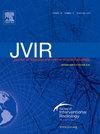药物洗脱栓塞支气管动脉化疗栓塞治疗肺癌的安全性和有效性:系统回顾与元分析》。
IF 2.6
3区 医学
Q2 PERIPHERAL VASCULAR DISEASE
Journal of Vascular and Interventional Radiology
Pub Date : 2025-02-01
DOI:10.1016/j.jvir.2024.10.023
引用次数: 0
摘要
目的评估药物洗脱栓塞支气管动脉化疗栓塞术(DEE-BACE)在肺癌中的疗效和安全性,并比较其与传统支气管动脉化疗栓塞术(cBACE)的疗效:对PubMed、Embase、Cochrane Library、Web of Science、CNKI、VIP和万方数据库进行了全面检索。当I2≥50%时,采用随机效应模型分析;否则,采用固定效应模型分析。当I2值≥50%时,进行亚组分析。共纳入18项研究,涉及681名患者,其中501名患者接受了DEE-BACE治疗,110名患者接受了cBACE治疗:在接受DEE-BACE治疗的肺癌患者中,1个月和6个月的汇总客观反应率(ORR)分别为64.4%和50.3%;疾病控制率(DCR)分别为93.4%、74.4%和71.7%。1年总生存率(OS)和无进展生存率(PFS)分别为48.2%和22.5%。不良反应发生率低于50%。与 cBACE 组相比,DEE-BACE 组的 1 个月 DCR 更高[汇总相对风险 (RR):1.236,95% 置信度]:1.236,95%置信区间(CI):1.028, 1.486)、6个月(汇总RR:2.036,95%CI:1.226, 3.383)ORR和DCR(汇总RR:1.824,95%CI:1.249, 2.662)。DEE-BACE和cBACE的不良反应发生率相似:结论:与cBACE相比,DEE-BACE在肺癌治疗中具有良好的疗效和安全性,特别是对于不可切除病例或化疗或放疗选择有限的情况。然而,由于缺乏与标准治疗方法的直接比较,因此需要谨慎解释这些结果。本文章由计算机程序翻译,如有差异,请以英文原文为准。

Safety and Effectiveness of Drug-Eluting Embolic Bronchial Arterial Chemoembolization for Lung Cancer: A Systematic Review and Meta-Analysis
Purpose
To assess the effectiveness and safety of drug-eluting embolic (DEE) bronchial arterial chemoembolization (BACE) in lung cancer and compare its outcomes with those of conventional BACE (cBACE).
Materials and Methods
A comprehensive search was conducted across PubMed, Embase, Cochrane Library, Web of Science, CNKI, VIP, and Wanfang databases. Random-effects model analysis was applied when I2 was ≥50%; otherwise, fixed-effects model analysis was used. Subgroup analysis was performed for I2 values of ≥50%. Eighteen studies involving 681 patients were included, with 501 patients receiving DEE-BACE and 110 patients undergoing cBACE.
Results
Among patients with lung cancer treated with DEE-BACE, the pooled objective response rates (ORRs) at 1 and 6 months were 64.4% and 50.3%, respectively; the disease control rates (DCRs) at 1, 3, and 6 months were 93.4%, 74.4%, and 71.7%, respectively. The 1-year overall survival and progression-free survival rates were 48.2% and 22.5%, respectively. The incidences of adverse events such as cough, fever, chest discomfort, nausea, fatigue, and leukopenia were reported at 30.7%, 22.8%, 22.4%, 29.6%, 7.4%, and 21.8%, respectively. Compared with the cBACE group, the DEE-BACE group exhibited higher 1-month DCR (pooled relative risk [RR], 1.236; 95% confidence interval [CI], 1.028–1.486) and 6-month ORR (pooled RR, 2.036; 95% CI, 1.226–3.383) and DCR (pooled RR, 1.824; 95% CI, 1.249–2.662). Both DEE-BACE and cBACE exhibited similar rates of adverse events.
Conclusions
DEE-BACE presents a favorable effectiveness and safety profile for lung cancer treatment compared with cBACE, particularly for nonresectable cases or when chemotherapy or radiation therapy options are limited. However, the lack of direct comparisons with standard treatments requires cautious interpretation of these results.
求助全文
通过发布文献求助,成功后即可免费获取论文全文。
去求助
来源期刊
CiteScore
4.30
自引率
10.30%
发文量
942
审稿时长
90 days
期刊介绍:
JVIR, published continuously since 1990, is an international, monthly peer-reviewed interventional radiology journal. As the official journal of the Society of Interventional Radiology, JVIR is the peer-reviewed journal of choice for interventional radiologists, radiologists, cardiologists, vascular surgeons, neurosurgeons, and other clinicians who seek current and reliable information on every aspect of vascular and interventional radiology. Each issue of JVIR covers critical and cutting-edge medical minimally invasive, clinical, basic research, radiological, pathological, and socioeconomic issues of importance to the field.

 求助内容:
求助内容: 应助结果提醒方式:
应助结果提醒方式:


